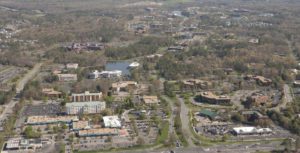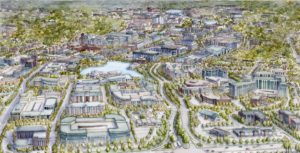Will Henrico County embrace its inner urbanity?
Highwoods Properties, owner of roughly one-third of the Innsbrook Corporate Center, has asked the county to rezone 188 acres to allow intensive, mixed-use development, including office towers up to 16 stories tall. If approved by the county, the project would commence the transformation of the second largest employment center in the Richmond region from a meandering 80s-era campus of two- to three-story offices surrounded by parking lots and tree groves into an urban oasis. (Click on photos to view more legible images.)
The Highwoods plan calls for an additional 3.5 million square feet of office space, 415,000 square feet of retail and restaurant space, 1,000 hotel rooms and 6,000 residential units to be redeveloped over 20 years, reports the Times-Dispatch. “We have come as far as we can as a suburban office park,” said Paul W. Kreckman, Highwoods vice president. “We are very proud of it, it is beautiful, it is great. But you can’t stay here, you got to move on.”
The Henrico Board of Supervisors must approve the request but it laid the groundwork in September 2010 by adopting the Innsbrook Area Study study, which designated a 1,351-acre tract in the western county as an Urban Development Area (UDA). The study articulated a set of guiding principles for the area, including the need for (a) greater density, (2) a balance of jobs, housing, retail, entertainment and other amenities, and (3) urban design that encourages walking and mass transit as an alternative to the automobile.
The study critiques the current design, which separates buildings by large areas of surfacing parking, places services and amenities on the periphery, and banishes all housing, thus forcing people to use automobiles for nearly every trip. Henrico planners recognize that traditional “suburban” development (low densities, separated land uses, cul de sac subdivisions, massed concentrations of retail) will not be able to economically accommodate anticipated residential growth of 50,000 new housing units by 2026.
The county’s goal is to maintain a ratio of 65% residential to 35% nonresidential development, not just countywide but within the Innsbrook development area. It makes sense to locate a portion of that residential growth close to the county’s largest employment center on the grounds that it “could reduce workforce dependency on the automobile.”
The need for balance goes beyond housing and jobs. It extends to daily services such as grocery stores, banks and childcare. Re-development also should support mass transit and, above all, walkability. The study aims to create a comprehensive “pedestrian circulation system” by means of grid or modified-grid streets, individual blocks, alleyways, sidewalks and streetscapes, paths, trails and links to adjacent neighborhoods. Cul de sacs and other dead-end streets should be avoided unless necessitated by the presence of natural features or other site constraints.
The big question is whether existing connectors, such as the congested Broad Street Corridor and the under-utilized Nuckols Road can handle the increased traffic. In theory, if enough people can accomplish most of their trips on foot, in trams or in short car trips within the re-development area, the densification of jobs and residents will have only a modest impact on connector roads and Interstates. Henrico County undoubtedly will have to spend to upgrade its connector streets, but it will arguably spend less than it would if the construction were all green-field development.
Henrico botched the planning in the nearby Short Pump area, a horrendous mass of strip and mall commercial development where the traffic bogs down in the worst congestion in the Richmond region. As a Henrico resident, I hope that the planners and supervisors get Innsbrook right. Early indications are that they will.




